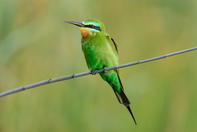
Name
Blue-cheeked bee-eater (Merops persicus)Appearance
The blue-cheeked bee-eater is a rich pastel coloured bee-eater. This bee-eater is mostly green in colour, with blue flanks. It has blue facial colours and a black eye stripe, a yellow and brown throat. One of the main identification features is the green crown and pale blue to whitish forehead. The tail has two tail streamers (elongated feathers) that extend for around 7 cm, adding to the total length of the bird at around 25 cm.Diet
The blue-cheeked bee-eater hunts flying insects in flight. Once they catch an insect, they will return to a perch to kill and remove its sting, by repeatedly hitting the insect against the branch. The blue-cheeked bee-eaters preferred insects are dragonflies, followed by damselflies and lacewings.Blue-cheeked Bee-eater Breeding
The blue-cheeked bee-eater does not breed in South Africa, they nest along the shores of the Caspian Sea.Blue-cheeked Bee-eater Behaviour
The blue-cheeked bee-eaters found in South Africa are non-breeding Palearctic migrants. A Palearctic migrant is a bird that migrates from a region that includes Europe, northern Asia, eastern Siberia and North Africa.
This bee-eater arrives in South Africa around October and departs around April, spending the northern hemisphere winter in South Africa.
The blue-cheeked bee-eater is very gregarious and is seen in flocks of up to 20 or more birds. They roost communally, bunched together in a line on a branch.